
Entering Varanasi’s old city feels going back in time. The city that was founded by Hindu gods. The city where Buddha first spoke. The city that was the heart of the Aryan settlement before Christ. Known as the holiest of Indian cities, the cultural capital of India and even the oldest living city in the world. If you only have one day to explore, you can still see a lot.
How to spend a day in Varanasi?
- Early morning aarti ceremony & yoga at Assi Ghat
- Chai at the Pappu Chai Stall
- Stroll along the lesser-known ghats to Dashashwamedh Ghat
- Eat a local street breakfast of kachori and sabzi
- Take a sunrise Ganges boat ride
- Spend time at the burning ghats
- Visit two to three temples such as the Ratneshwar Mahadev Temple, Kashi Vishwanath Temple, Tulsi Manas Mandir, Durga Mandir Temple, Bharat Mata Mandir, and Sankat Mochan Hanuman Temple.
- Take a short trip to popular sites like the Buddhist pilgrimage site, Sarnath, the home of kings, Ramnagar Fort, or the Sarai Mohana village where Banarasi sarees are made.
- Sunset aarti ceremony at Dashashwamedh Ghat
- Dinner at one of the cities finest restaurants.
It’s difficult to decide because there is so much to see and do in Varanasi, and the city moves at its own pace. But if you’re focused you can get a sense of what is considered the oldest living city in the world and I’ve included options for you to customize your day.
Tips For Seeing Varanasi:

1) Come for the History and Mystery. Not the Luxury.
Varanasi’s thought to be the oldest city in the world. It has a population of 3.5 million people, and 40% live on less than 50 Rs a day. There aren’t many truly luxury resorts, except this one, but what you will find is a city that is so unique it would take books and books to describe it’s history.
Apparently it was founded by a god, Lord Shiva and his wife, Pavarti.
2) Come in the Winter.
The average temperatures are in the mid-60s °F (~15 °C) and there is very little rain. December is typically the busiest month for tourism in India, and Varanasi is no exception. January, February and even March are good too.
3) Get a Good Guide
If you only have a day, save time by getting a certified guide. You could do a one-day tour or design your own tour with the information below.
Early Morning
NOTE: The numbers in the map correspond to numbers in the post below.
4:30 AM
1) Aarti Ceremony at Assi Ghat: If you want to get the most of the day, then you can start super early. There are many aarti ceremonies in Varanasi, but this is one of the most special. Way before the sun comes up you’ll find the typical ceremony with priests waving aarti lamps, as well as a group of girls chanting the Rig Veda. There are people learning yoga. This ceremony is popular with locals and tourists. It’s safe. It usually goes for 45 minutes to an hour. Afterward, you can hang around and do yoga here at 6 am and there is live music after that at 7am.
5:30 AM
Pappu Chai Stall: Near the Assi Ghat, you can get a hot sweet tea to wake up. This stall doesn’t have a fancy neon sign but it has been running in Varanasi for more than 80 years. You can get good chai here and political conversations if you hang around to chat with the old guys who trickle in throughout the morning. Don’t worry about getting sick, because they clean each glass meticiously making it a great place to chill before the sun comes up.
Kashi Tea Stall: For an alternate, you could try the lemon tea here. They have other types and the masala tea or creamy coffee are great too.
Stroll along the Ghats: Walk north from the Assi Ghat towards the Dashashwamedh Ghat to the center of Varanasi. There you will be able to find some good boats for a sunrise boat ride. Before that, though you can check out some other more low-key ghats. Here are some that are on the way:
- Tulsi Ghat: Just north of Assi Ghat, it is named after a famous saint and poet, you can find Tulsidas’ remains here as well as a few of his belongings. The waters here are thought to keep you free of leprosy.
- Darbhanga Ghat: Just south of the Dashashwamedh Ghat is a good photograph spot, it has the huge sandstone palace that was bought by the king of Darbhanga in 1915.
- Digpatiya Ghat: Just south of the Darbhanga Ghat is a small ghat that has a Bengali Palace built by the king of Digpatiya. It is said Madhusudan Sravasti, a great Indian philosopher lived here.
- Jain Ghat: It has three Jain temples and it is thought to have been owned by the ancient Jain kings.
- Kedar Ghat: This is one of the busier ghats and has the Gauri Kund, a pond named after Lord Shiva’s wife. It is one of the oldest ghats in the city.
- Chet Singh Ghat: This ghat has a fort-like palace with the same name. It was named after the first ruler of Varanasi’s illegitimate son Chet Singh. He came to rule the city by bribery and ended up fighting with Warren Hastings, the first Governor-General of India.
- Harishchandra Ghat: This ghat is named after a legendary king of Varanasi and has an electric crematorium.
- Lalita Ghat: Just next to the Dashashwamedh Ghat, this ghat is named after the Queen of Nepal.
- Scindia Ghat: Just north of Dashashwamedh Ghat, here you’ll find the leaning submerged temple. Agni, the Hindu God of Fire was also born here.

What is a ghat? A set of steps or a path leading to a river. It is also used to describe step-like mountains such as the Western Ghats in India or a difficult passage through the mountains.
2) Local street food for breakfast: As you get close to the Dashashwamedh Ghat, you can head out towards the road and find plenty of street food vendors starting their day. The locals in Varanasi eat standing up, and you can find some delicious street food here. The typical local breakfast is kachori (deep-fried bread with filling) and sabzi (vegetables cooked in spiced gravy). Then they follow it up with a sweet jalebi (flour pretzel cooked in syrup).
- Badi Kachori is filled with masala made from dal (lentils).
- Choti Kachori is filled with cooked potatoes with spices.
- Aloo Sabzi is a potato curry that complements the kachori.
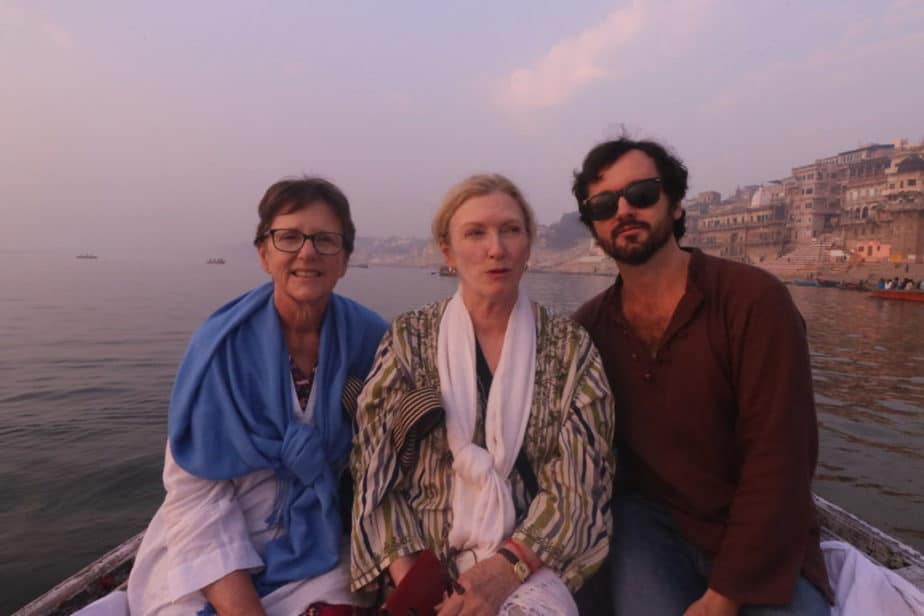
7:00 AM
Sunrise Ganges Boat Tour: If you walk along the ghats it won’t be long before an enterprising boat captain will try to sell you a boat ride. You have a few options from motorized large boats that you share to the smaller private rowboats. I recommended spending an extra 150 Rs to get a private boat as they will take you wherever you want to go. Be sure to negotiate and prices should be about: 150 Rs for shared boats. 250 Rs for private boats.
Places you’d want to see would be Manikarnika Ghat (the burning ghats) and Assi Ghat. You could go to the other side of the river to photograph the city. It’s nice to get a guide and hear about the significance of the various ghats. It also can be quiet with a warm pink light reflected off the Ganges. I liked watching the bathers dipping in the water, washing their clothes, performing their prayers and more.
Morning
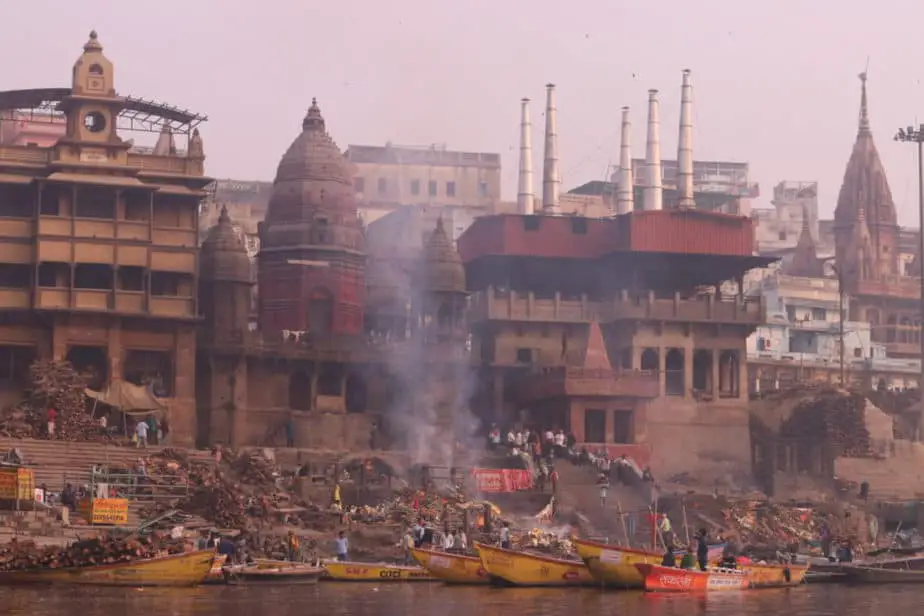
9:00 AM
3) The Manikarnika Ghat or Burning Ghat: This ghat is the main cremation grounds and is often just called the burning ghat. All Hindus want to visit because Varanasi is where you can break the cycle of rebirth. To get bodies to this crematorium, four family members will carry the body covered in colorful fabric and flower garlands. The family will explain to the owner of the ghat why the person has died, and once the owner is satisfied they will need to purchase about 350 kilograms of wood to burn the body. The body will then be washed in the Ganges River by the family, then taken to the pyre. Where the pyre is lit from the flame that has been burning for 3,500 years. Once a person is burned here it is thought that they immediately attain enlightenment or moksha or salvation.
Tips: Don’t accept any guides who won’t show you their license. Don’t take photographs at the ghats (you can photos from a boat if you wish and are discreet). Do hire a licensed guide and hear the story of this ghat, many of them are very good and can help you gain more of an understanding of this unique place. Do spend some time sitting on the steps.
Ratneshwar Mahadev Temple: This is also known as the submerged slanted temple because it is built very low and the water can reach the shikhara (spire). It’s in the Scindia Ghat, next to the burning ghat, and has a tragic beauty to it. In the winter, the entrance is submerged but it is said that priests have swum in to conduct ceremonies. In the summer, the water level goes down and some visitors can go inside. Some say this temple is cursed. Others say the construction went wrong. Others say the foundation shifted. No one knows for sure what happened but it is a beautiful sight.
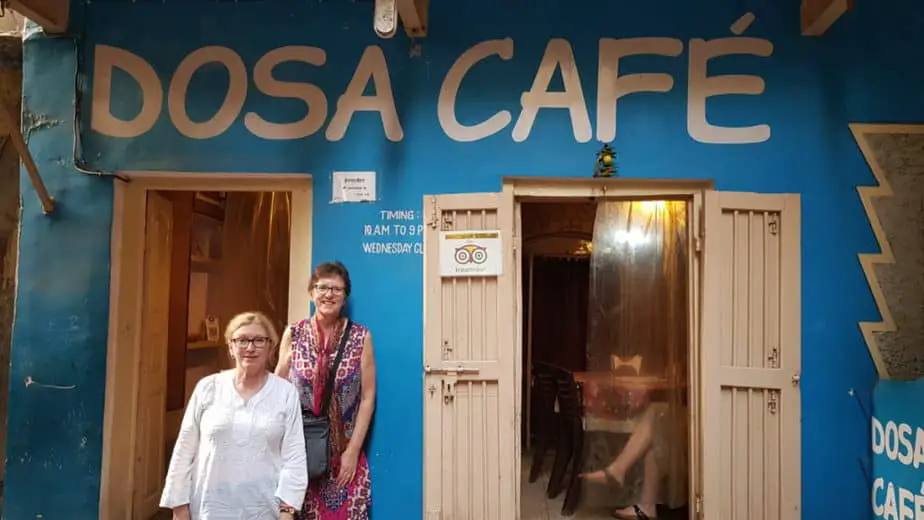
11:00 AM
4) Have a Lassi: Not far from the Burning Ghat is the Blue Lassi. This place has over 80 lassi varieties and is a good place to chill out after having a busy morning. The lassis are made with malai cream and topped with pistachios and fruits.
5) Have a Dosa: The Dosa Cafe has three tables and specializes in dosas, which is a savory Indian pancake you can get at almost every restaurant. However, here Chef Ranjana designed a menu with unique options such as the chocolate dosa or chili cheese dosa. It’s a short walk from the Dashashwamedh Ghat as well.
6) Kashi Chat Bandar: This is another great street food place serving chaat… meaning snack. It’s like eating an appetizer, except you’re not having dinner afterward. Here you’ll find Pani Puri or Dahi Puri (little balls made of a thin shell of flour with fillings). They serve Aloo Tikki (it reminds me of a hash brown, a small pattie made out of potatoes, vegetables and spices). It’s a 10-minute walk from Dashashwamedh Ghat.
Other popular street foods you can find at many stalls:
- Malaiyyo: This saffron and cardamom flavored milk topped with almonds and pistachios is a winter dessert you can find in many street food stalls. It’s usually served in a clay pot (kullad).
- Choora Matar: It’s a version of Poha, a rice dish. This flat rice is spiced and has peas with raisins and saffron.
- Thandai: This drink often has fruit puree with rose essence, cardamom, saffron, ice-cream, dry fruits, and nuts. If you are feeling adventurous, try it with bhang.
- Jalebis with rabri: Jalebi is flour soaked and fried in sugar in the shape of a pretzel. Rabri is a creamy milk dish made of condensed milk. They go well together.
- Tamatar Chaat: It’s Varanasi’s version of Aloo chaat, made with boiled potatoes, tomatoes, green chilies, onions and coriander. Beware: this is spicy. You can find it at Deena Chaat Bhandar.
- Chena Dahi Vada: Lentil fritters with sweet curd and spices like masala with jeera and black salt. These are often eaten for breakfast and have a delicious blend of sweet and sour flavors.
Afternoon
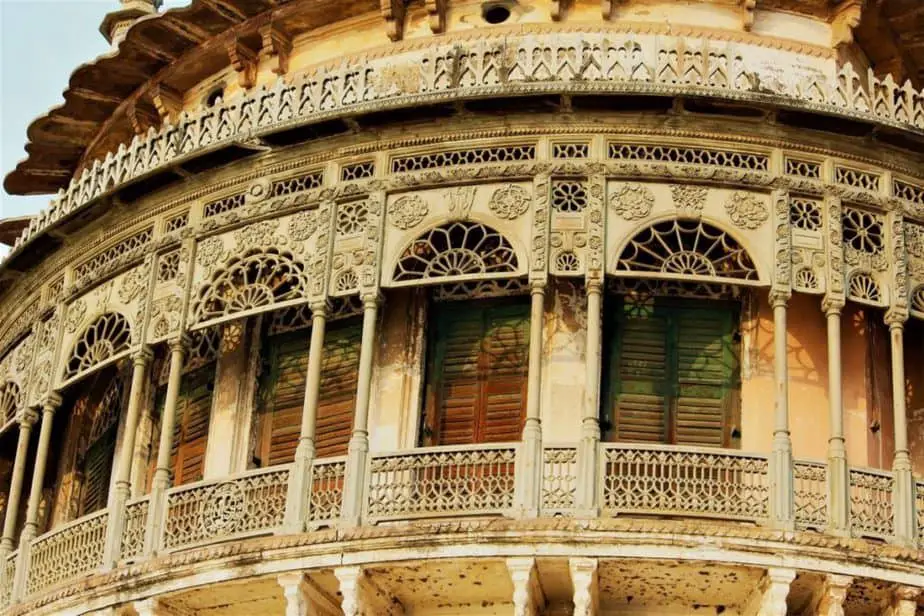
You won’t be able to see everything but look through these destinations and choose two or three that you’d most want to see.
7) Kashi Vishwanath Temple: The famous temple with three domes covered in gold. It is one of the most popular temples in all of India. The golden chatra is thought to grant you any wish you’d like. There is a Shiva Lingam which is said to give you salvation if you see it. There is a long line which may not allow foreigners in.
8) Bharat Mata Mandir: This temple was built before India’s Independence and has a beautiful and detailed map of Pakistan, Bangladesh, Myanmar, Afghanistan, and Sri Lanka as an undivided India. It represents Gandhi’s vision which is why the Mahatma inaugurated the temple in 1936. The map is huge and carved from white marble. You can see raised mountains like Mt. Everest and K2. You can also see the Great Wall of China depicted.
9) Sankat Mochan Hanuman Temple: This temple is devoted to Lord Hanuman and founded by the famous poet Tulsidas in the 16th century. Today you can buy and offer sweets called besan ke ladoos. Offer one to the god and another for you and you will be happy you tasted them.
10) Tulsi Manas Mandir: This is a newer temple built in 1964. Not far from the Durga Temple, this temple honors Rama and is made of white marble with a lush garden. The walls are covered with scriptures and there are figures depicting the Bhagavad Gita upstairs.
11) Durga Mandir Temple: It’s named after the God of War, who rides a lion into battle. But is also called the monkey temple, because of the wide range that have made this temple their home. The legend states that the image of the Goddess wasn’t built by anyone, yet appeared on its own. It’s red and has a pond on the right side.
Banarasi Paan: Betel nut leaves are a stimulant. They are eaten with tobacco or lime and called paan. Across India you can find many combinations made with the leaves, and Varanasi has it’s own variety. You can find some great paan at Keshav Tambul near Ravidas Gate.
Baba Black Sheep: For Indian shawls and scarves you can find a nice selection here with a personable staff. They will show you how to tell an authentic pashmina from a fake. You can also find Banarasi sarees. The prices are pretty good.
Sarnath: In the same way that the Ganges River is a pilgrimage site for Hindus, the nearby city of Sarnath is a pilgrimage site for Buddhists. This is the first place that the Buddha spoke after becoming enlightened. As the centuries went on the well-known King Ashoka honored him with stupas (dome-shaped buildings), temples and statues. It’s just 10 kilometers from Varanasi’s old city and is a beautiful place to spend an afternoon. To save time you could try a ‘skip the line’ tour. The Statue of Standing Buddha is very impressive. The Tibetan Temple here has hosted the Dalai Lama on a number of occasions. The Garden of Spiritual Wisdom is a lush beautiful place to walk around.
Banarasi Saris: If you have time, the Sarai Mohana village is just 5 kilometers north of Varanasi and has many of the artisans who make some of the best saris in the area. Making a sari is not quick nor easy and these craftsmen put a lot into making them beautiful and unique. It can take as little as 15 days to make one, and as much as 6 months. It’s recommended that you book a tour so you can gain inside access to the artists.
Ramnagar Fort: The home of kings, it has a collection of old cars that the kings had. There is also a museum with historical clothing, art, weapons and more. The architecture and balconies are ornate and designed in the Mughal-style. When I see the balconies I think they are a beautiful place to have tea. You can also see an outside perspective of the city from the balconies since the fort is on the eastern bank and just south of central Varanasi.
Evening
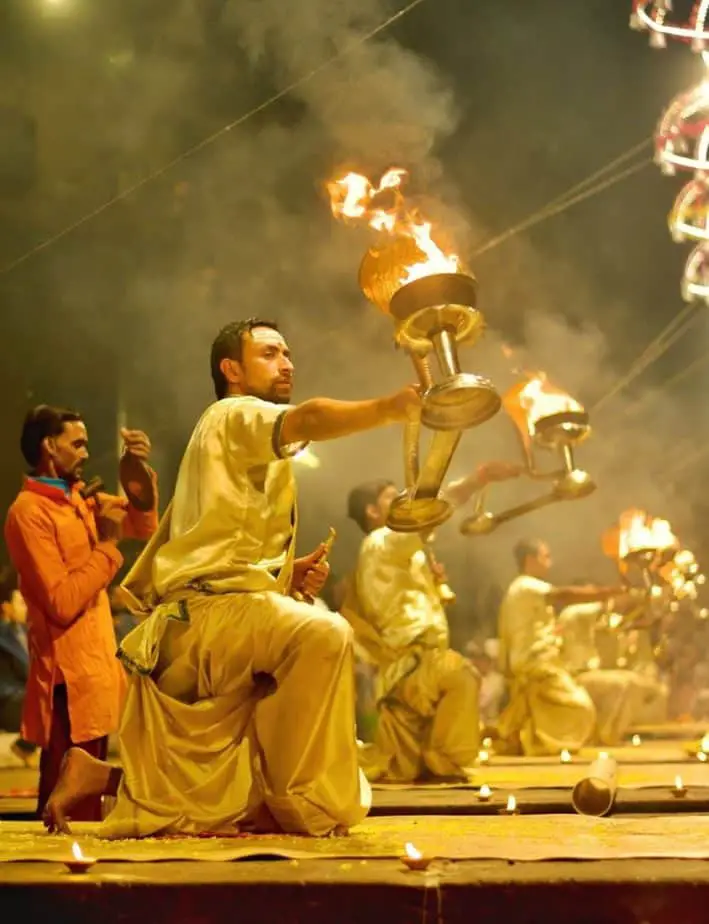
Ganga Aarti at Dashaswadmedh Ghat: This is the main event in Varanasi. Held every day as the sun goes down, the seats are set up like you are attending a rock concert. The aarti lamps are lit. The devotees pray to Mata Ganga, the Ganges River. There are 7 priests perform on platforms wearing silk dhotis with gold colors, orange kurtas and stoles across their shoulders. They are color-coordinated and move in a synchronized rhythm. The platforms they stand on are adorned with flowers, copper pots and a conch shell. The priests are lit with electric and oil lamps, and lead the crowd in chants and songs.
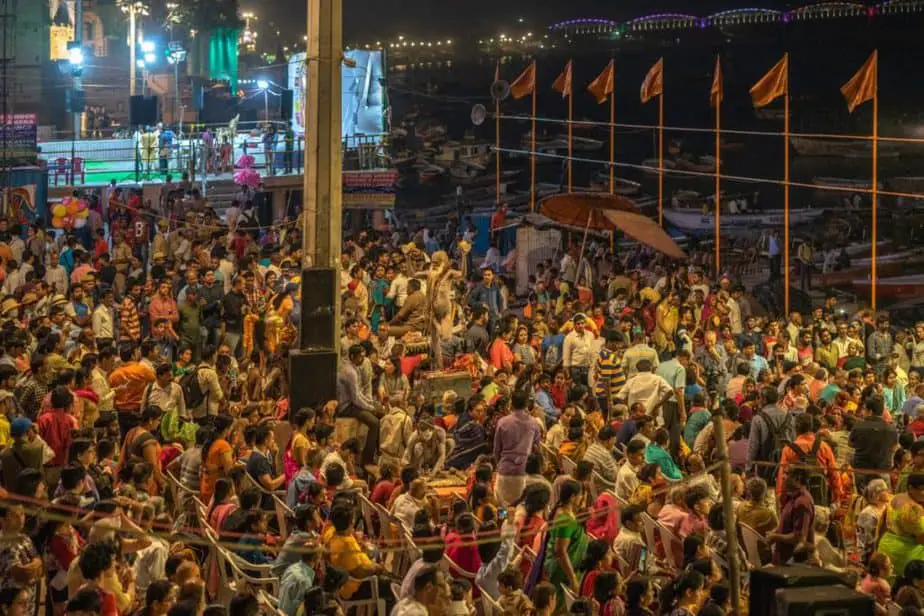


Dinner
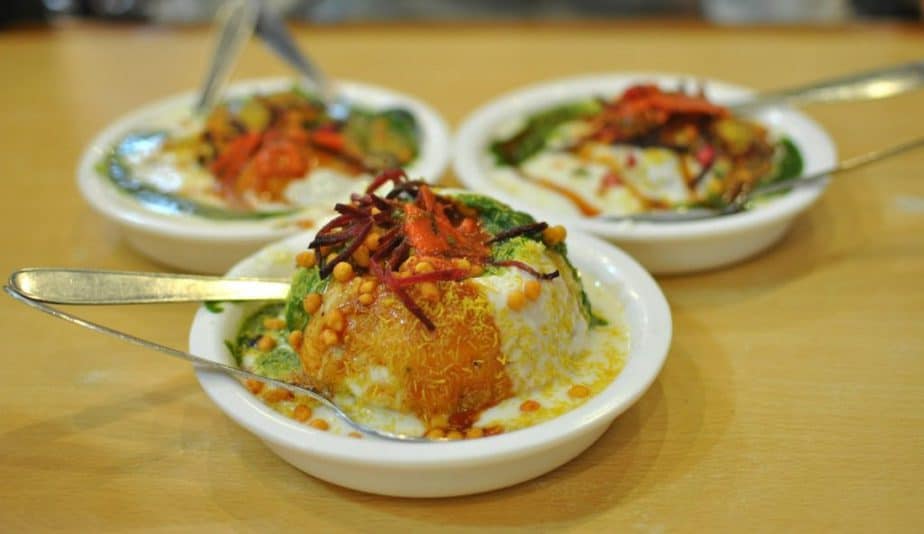
Brown Bread Bakery: If you’re craving a European style meal, this favorite with travelers has over 40 types of European quality cheeses, as well as enough cookies, cakes and breads to satisfy a Frenchmen. It also has an attached Vegan & Raw restaurant with a delicious menu of salads and pasta.
Darbhanga: For luxurious Indian food, this restaurant is in the nice Brijrama Palace hotel on the ghat by the same name. If you want to eat like a king or queen, this is the place. The options you have for the thali is amazing and the service is top-notch. The room is also similar to a 5-star hotel.
Pizzeria Vaatika Cafe: Near Assi Ghat, you can enjoy a Margherita pizza as you watch the sunset on the river. For dessert, there is apple pie and ice cream.
Roma’s Cafe Diner: This place gets great reviews with people loving the veggie pizza, pasta, biryani, Pao chicken and sandwiches. Their coffee and cappuccinos are great too. The staff does a great job as well. The average prices are 800 Rs for two people.
Baati Chokha: This street food joint is popular and on Dashaswmedh Road. People love the thali, liti chokha, phatti paneer and more. The average prices are 450 Rs for two people.
Shree Cafe Vegetarian Restaurant: Within a 5-minute walk from the Dashaswadmedh Ghat is a nice healthy restaurant with 10 tables or so. There were beautiful photos of Naga Sadhus on the walls and North Indian, Chinese and Italian food. The average prices are 800 Rs per person.
Night
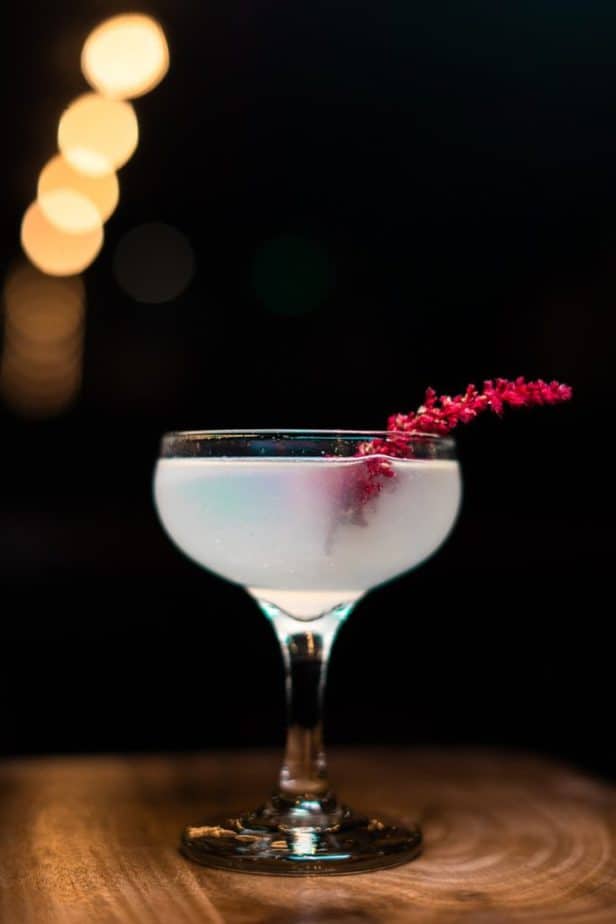
Alcohol is banned in the old city. If you’d like to get drinks, then head to the Cantonment area. Many hotels provide drinks until 11 pm or midnight. There are a couple of popular places not too far from the old city though:
The Third Floor Stock Exchange: This is one of the most popular places to get drinks and reminds me of a sports bar. You can play pool. The chilli paneer and white sauce pasta is recommended. They have a big list of 75 cocktails and also mocktails. The average prices are 1,400 Rs for two people.
The Big Taamash Cafe: This is the other option close to the old city in Varanashi. People like the noodles and tikka dishes. The DJ is recommended. The average prices are 1,000 Rs for two people without alcohol.
Summary:
If you have the time, you could spend weeks exploring Varanasi and getting to experience all this ancient city has to offer. But if you choose a handful of the things to do above, you will definitely have an epic day in this beautiful unique city.
For more about Varanasi, check out my 83 Do’s and Don’ts in Varanasi to help you prepare for your trip.
For more about planning your India trip, check out my ultimate travel checklist for India with a free PDF.

